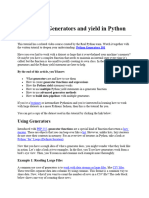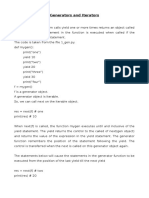0% found this document useful (0 votes)
13 views5 pagesGenerators and Iterators in Python
This document provides an introduction to iteration in Python, focusing on the Iterator Protocol and the use of generators. It explains how to create custom iterators using classes and contrasts this with the simpler approach of using generator functions with the yield keyword. The advantages of generators, such as lazy evaluation and memory efficiency, are highlighted, along with a comparison between custom iterators and generators.
Uploaded by
raghuveera97nCopyright
© © All Rights Reserved
We take content rights seriously. If you suspect this is your content, claim it here.
Available Formats
Download as PDF, TXT or read online on Scribd
0% found this document useful (0 votes)
13 views5 pagesGenerators and Iterators in Python
This document provides an introduction to iteration in Python, focusing on the Iterator Protocol and the use of generators. It explains how to create custom iterators using classes and contrasts this with the simpler approach of using generator functions with the yield keyword. The advantages of generators, such as lazy evaluation and memory efficiency, are highlighted, along with a comparison between custom iterators and generators.
Uploaded by
raghuveera97nCopyright
© © All Rights Reserved
We take content rights seriously. If you suspect this is your content, claim it here.
Available Formats
Download as PDF, TXT or read online on Scribd
/ 5




















































































